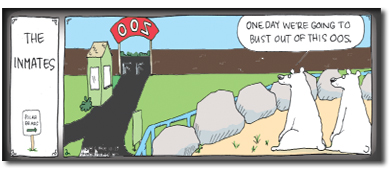|

Original sketch courtesy of Hilary Price.
What rhymes with orange? Thirteen years ago, Hilary Price liked that puzzler enough to name her comic strip after it. Today, "Rhymes With Orange" is syndicated in 150 newspapers nationwide.
Of course, cartoonists do more than choose a clever title for their work. Cartoons (which include comic strips) must convey an idea visually, often humorously, and range from single frame gags to multipanel serials to graphic novels. Hilary, like most
syndicated cartoonists, writes and draws 365 different comic strips per year: black-and-white strips that run Mondays through Saturdays, and color ones on Sundays.
An idea is central to each strip. Because cartoons can be a form of social commentary, cartoonists need to keep up with current events. They also have to look ahead, though, to submit a week’s worth of strips at least 1 month before the cartoons
appear in print. And since today’s news might be stale tomorrow, creating for the future makes timeliness tricky. "I have to be thinking not in terms of events," says Hilary, "but in terms of trends."
Hilary peruses many sources, including newspapers and magazines, to get ideas from emerging trends, phrases, and words. But she also brainstorms topics in other ways. For example, she might sit down at her desk and just let her mind wander, which
"helps the body tell the brain, ‘It’s time to work,’" she says. Other times, she thinks of an odd situation and works backward from that point, creating a humorous explanation for the circumstance. And she never underestimates the value of
conversation. "When I’m hanging out with my friends, and we’re talking, there may be the seed of an idea in our bantering back and forth," Hilary says.

Rhymes With Orange © Hilary B. Price. King Features Syndicate. Reprinted with special permission from King Features Syndicate.
Once she has the kernel of an idea, Hilary begins to develop it. "I’ll start asking myself questions," she says. "‘What’s the best way to present this idea: Two people talking? One person? An animal?’ ‘What’s the fastest way
for the reader to get the joke?’" After she makes those choices, she starts thinking about how she will illustrate the idea using the fewest words possible.
Then it’s time to draw. Some cartoonists use computer software to draw their illustrations; others sketch by hand. Hilary drafts creations in pencil, then goes over them in ink and erases the pencil marks. But before finalizing each strip in ink, she
gets a fresh perspective from a friend on whether her idea—as well as her expression of it—is effective.
Eventually, Hilary scans the comic strip into a computer. Color for Sunday strips is added electronically; in addition, technology helps cartoonists hide the flaws that are part of the creative process. "The originals are not pristine," says
Hilary. "When I ink them, I might make a mistake and use correction fluid to cover it up. But I clean them up on the computer, and that’s what the reader sees."
Hilary sends comic strips to her syndicate in daily-plus-Sunday batches. The syndicate serves as a clearinghouse, distributing to its subscribing newspapers the comics that
occupy space on their pages. There are about five major syndicates, "and all of them are competing for real estate on the page," says Hilary.
A syndicated cartoonist’s earnings are tied to that competition; a cartoonist whose work is in a handful of newspapers isn’t likely to make as much as another whose strip appears in hundreds, for example. But it’s not all about page space. Rates
charged to subscribing publications are based on the size of the publication’s circulation, the frequency with which the strip runs, and the strip’s popularity in a given market. The syndicate and the cartoonist typically split the proceeds.
It can take awhile for new cartoonists to build a following, but popularity creates opportunities for additional income. Sales of cartoon-related products—including clothing, greeting cards, coffee mugs, and books with "best of" collections—can
help well-known cartoonists boost their earnings.
The U.S. Bureau of Labor Statistics (BLS) does not collect data on cartoonists, so BLS does not have wage or employment information available on them. But industry sources suggest that earnings start at about $30,000 for beginning cartoonists, and
established cartoonists with successful product sales can earn significantly more. The number of syndicated cartoonists in the United States is estimated to be about 250.
Most syndicated cartoonists do not work on their strips full time, even if cartooning is full-time work. The time-consuming responsibilities of being self employed, as most cartoonists are, include paying bills, filing paperwork, and doing marketing
activities, such as maintaining a Web site and responding to editors and fans. "I can spend an entire day doing administrative stuff," says Hilary. "There’s an entrepreneurial aspect to this job, but I didn’t come out of school with business
acumen." Hilary recommends that students interested in cartooning or any creative field get some kind of training in how to run a business.
No formal training is required to become a cartoonist, although some cartooning programs now exist either independently or within postsecondary schools’ visual arts departments. But Hilary, who majored in English, considers communication skills more
critical for cartooning than artistic ability. "There’s an unspoken rule of newspaper comics," she says. "You can have bad art and good writing, but you can’t have bad writing and good art." She also emphasizes the importance of consistency:
being able to stay motivated to create a cartoon for every day of the year.
A good way to stay motivated is to gain confidence—and a good way to gain confidence is to see your work in print. Hilary suggests that aspiring cartoonists start small, as she did, by talking to editors of local newsletters and school newspapers
about getting a strip published.
Occasional publication also helps to build a portfolio, which then makes it possible to send out feelers. In Hilary’s case, one successful solicitation amid several rejections led to a development contract, which eventually led to a long-term
syndication contract.
As for what rhymes with orange, no single word in the English language does, aside from a few proper nouns (including Blorenge, a mountain in Wales). For Hilary, sharing that inside joke with readers of "Rhymes With Orange" reminds her of why she enjoys
creating amusement. "I really like doing cartoons. I really like that creative piece," she says. "There’s great personal satisfaction in it."
 Top Top
|



